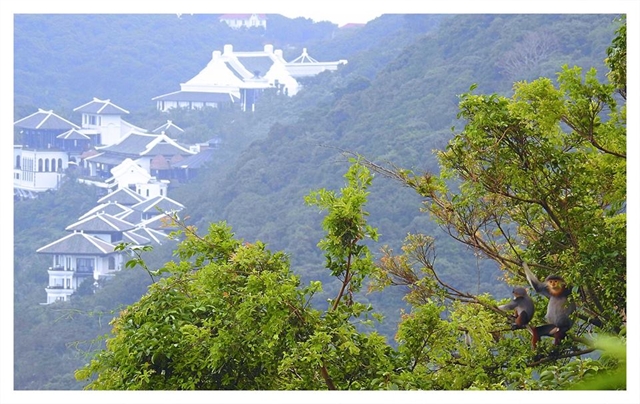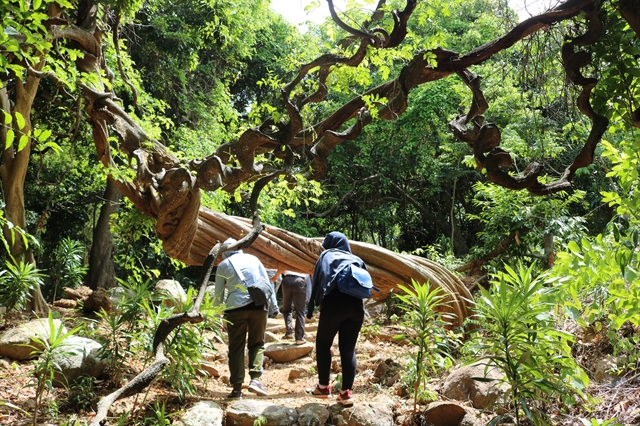Human activities in the Sơn Trà Nature Reserve had changed the basic instincts of langurs and monkeys, while threatening the primate population with human-to-wildlife transmitted diseases, according to biologist Trần Hữu Vỹ.

A troupe of endangered red-shanked douc langurs can be found living near a resort in Sơn Trà Nature Reserve in Đà Nẵng. Booming construction and poor control of mass tourism has threatened the existance of the species and biodiversity in the reserve. — VNS Photo Lê Phước Chín
Biologists and researchers warned that eating human food and rotten leftovers would result in serious jungle pollution and the extinction of some species in the reserve.
Rangers have witnessed the red-shanked douc langur – an endangered primate only found living in Việt Nam and Laos – crossing power lines to seek food in separated jungles.
Scientists have voiced their concerns about the negative impacts on the habitat of monkeys and langurs in the Sơn Trà reserve caused by humans feeding them.
The city has yet to find an effective solution to deal with the conflict between humans and wildlife in the reserve, including feeding wildlife, rubbish disposal, vehicle noise and illegal logging.
Monkeys can be seen heading downhill to look for food from tourists and dustbins at the Linh Ứng Pagoda and resorts in the Sơn Trà Nature Reserve.
At least 10,000 people visit the areas every month, causing noise pollution and leaving leftovers and rubbish in the reserve, a report from the Sơn Trà management board said.
Visitors are allowed to drive their motorbikes into the core zone without permission or ID, but a ban on staying overnight in the reserve has recently been issued by the local administration to ease the situation.
But illegal hunting, tourists dying on jungle adventures and aggressive monkeys have made the situation worse.
The reserve is managed by different agencies, including the Sơn Trà-Ngũ Hành Sơn forest protection sub-department; Thọ Quang Ward’s administration; Sơn Trà Peninsula’s management board of beaches and tourism; and the Border Guard, Air Defence and Navy.
Each agency only manages one assigned area, but an overall management board has not been set up.

A monkey is offered food by a tourist in the reserve. Tourists have been warned not to feed wild animals living in the reserves in Sơn Trà and Bà Nà. — VNS Photo Trần Hữu Vỹ
Solution
Biologist Vỹ said the 4,400ha Sơn Trà Nature Reserve should be recognised as a UNESCO world biosphere site to promote eco-tourism services while protecting the rich biodiversity of flora and fauna.
He said the proposal had been raised among biologists, scientists and experts during several conferences and seminars in the city and central region with the aim of dealing with the conflict between socio-economic development and nature conservation.
He said a UNESCO-recognised world biosphere reserve would create huge revenue for the city from eco-tourism services, and help protect the animals with strict rules.
“It would be a good way for Đà Nẵng to boost economic growth through eco-tourism, while acting as a rendezvous point for top biodiversity researchers and experts.
“A UNESCO-recognised world biosphere reserve would be good for Đà Nẵng to deal with mass tourism and rapid infrastructure development,” Vỹ told Việt Nam News in an exclusive interview.
“The site has yet to earn a penny from eco-tourism. Overlapping management among agencies add serious threats to biodiversity in the reserve and the existence of the red-shanked douc langur – an endangered primate listed by the International Union for Conservation of Nature (IUCN),” he said.
More than 1,300 red-shanked douc langurs, which are found only in east-central Laos and Việt Nam, were reported living in the Sơn Trà Nature Reserve, and the existence of the endangered species would be a crucial factor for promoting the reserve to UNESCO, Vỹ said.
Green lungs
Dr Hà Thăng Long, head of the Frankfurt Zoological Society office in Viet Nam, said Sơn Trà and Bà Nà-Núi Chúa were ‘green lungs’ supplying millions of tonnes of oxygen to residents and tourists.
He said the two reserves played important roles in biodiversity conservation, and were home to precious flora and fauna that would lure scientists and researchers from around the world.
“Our manners and food are quite different from the primates. Unripe fruit, leaves, and buds are major food for langurs, while ripe fruit is a favourite for the monkeys. However, tourists feed monkeys with human food like cakes and snacks,” he said.

Tourists on an educationional trip in the Sơn Trà Nature Reserve. Eco-tours and the world biosphere recognition will help the sustainable development of Đà Nẵng. — VNS Photo Lưu Ly
Up to now, 18 out of 25 hotels and resorts on the Sơn Trà Mountain and 85km of concrete roads have been approved and built by the city.
The Sơn Trà Nature Reserve, which is 600m above sea level, is known for its rich biodiversity, with 287 animal species and 985 plant species.